
POLS 1140
Social Groups and Identities
Updated Mar 9, 2025
Wednesday
Plan
Assignment 2
A realist theory of democracy (Chapter 8)
Evidence of the political Relevance of Group Identity (Chapter 9)
Friday: Pitfalls of group identity
Assignment 2
Sections
Today 5-6 pm Sayles Hall
Tomorrow 5-6 pm 101 Watson Room 116-A
Sections
Plan for section:
Review feedback to assignment 1 (10 minutes)
Review common content
Create account /Log into Qualtrics (click here)
1 person creates a new project and shares with:
- Group members
- Paul and Isaac
1 person creates a google doc (in shared google drive?) to:
- Summarize your revised research question
- Any additional questions/requests you have
- Supplemental materials (treatments) you want uploaded
Assignment 2
By Friday, October 25:
- Upload your draft survey instruments to Canvas
- Upload a memo (word doc) summarizing:
- your revised research question
- Your outcome of interest
- Your key predictors
- Additional questions/requests
Course feedback
If you haven’t done so already, please:
Click here be the change you want to see in this class
We’ll talk about results on Monday
Friday
Plan
Southern Identity and Partisanship
Attitudes toward abortion
Partisan Misperceptions
Assignment 2
By Friday, October 25:
- Upload your draft survey instruments to Canvas
- Upload a memo (word doc) summarizing:
- your revised research question
- Your outcome of interest
- Your key predictors
- Additional questions/requests
Attendance Survey!
Click here to be rewarded for your attendance on a beautiful Friday afternoon
An introduction to Social Identities
Social Identity
- Take a moment to write down all the social identities you possess.
My Social Identities
- White
- Male
- Sports fan (I agree, go Cavs)
- Catholic
- Democrat
- Married
- Irish and Italian
- Ithacan
- Academic
- Culture vulture
Social Identity
Now cross off the least important identity.
Now cross off the next least important identity…
Social Identity
- Social identities vary in
- Origin (voluntary vs involuntary)
- Strength
- Salience
- Effect
- People tend to
- Possess multiple identities
- Understand identities relationally (in-groups vs out groups)
- Exaggerate differences between groups and emphasize similarities within groups
A Realist Theory of Democracy
A Realist Theory of Democracy
“The primary sources of partisan loyalties and voting behavior … are social identities, group attachments, and myopic retrospection, not policy preferences or ideological principles.”
“How can we tell in any given case that identity is the key moving force?”
What is a social identity any way?
The Very Basis of Reasons (Chapter 8)
Traces the decline and reemergence of a more “realist” view of democracy with a focus on pluralist group conflict
What explains this decline and re-emergence of groups in political theory and science?
What needs to be done to “develop a modern group-theoretic understanding of political attitudes and behavior”
What explains this decline and re-emergence of groups?
Early scholarship places heavy emphasis on the role of groups in political life
- The Columbia Studies
Pluralism goes out of fashion during social and political unrest
Folk theories emphasizing populist ideals and rational retrospection gain favor
Advances in social psychology provide a theoretical and empircal foundation for understanding pluralist group conflicts through the lens of social identity theory
Evidence of Group Identity (Chapter 9)
Chapter 9 presents evidence of the important of “identities” to understanding political behavior using three types of evidence:
Historical analysis of Catholic voting behavior
Time series cross sectional survey analysis of the partisan identity and policy beliefs of White Southerners
Panel survey analysis of abortion attitudes and partisanship
Historical analysis of Catholic voting behavior
- What are the key takeaways from Figure 9.1?
- What evidence supports the claims:
- “[T]he impact of Kennedy’s candidacy on Catholic support for the Democratic Party was temporary” (p. 245)
- “It is hard to imagine a clear demonstration of the political impact of group attachments and the trade offs among them” (p. 244)
- Why was “the social significance of a Catholic presidential candidacy … no longer sufficient to produce substantial deviations from accustomed voting behavior” (p. 246)
Historical analysis of Catholic voting behavior

The Realignment of Partisan Identities in the South
Achen and Bartels present an alternative interpretation of realignment in the south emphasizing the role of social identities over standard accounts that emphasized partisan policies using the following evidence:
Analyzing trends in PID and Voting overtime (Fig 9.1) and by age cohort (Fig 9.2)
Analyzing trends in PID by policy position (Fig 9.4, 9.5)
Regression analysis predicting PID with feelings toward Southerners over time (Table 9.1)
White Southerners went from solid Democrats to consistent Republicans

- But note that votes change much faster than partisan identifications
Issue evolution alone doesn’t explain partisan realignment
Why? If realignment was driven by attitudes about racial policy, what would we expect to see in the figure below?

Regression Analysis

Regression Analysis
The results indicate that the Democratic partisan advantage in 1964 among white southerners who expressed neutral attitudes toward “southerners” was almost 25 percentage points, while the corresponding advantage among those who expressed very warm feelings toward “southerners” was more than twice as large, almost 55 percentage points
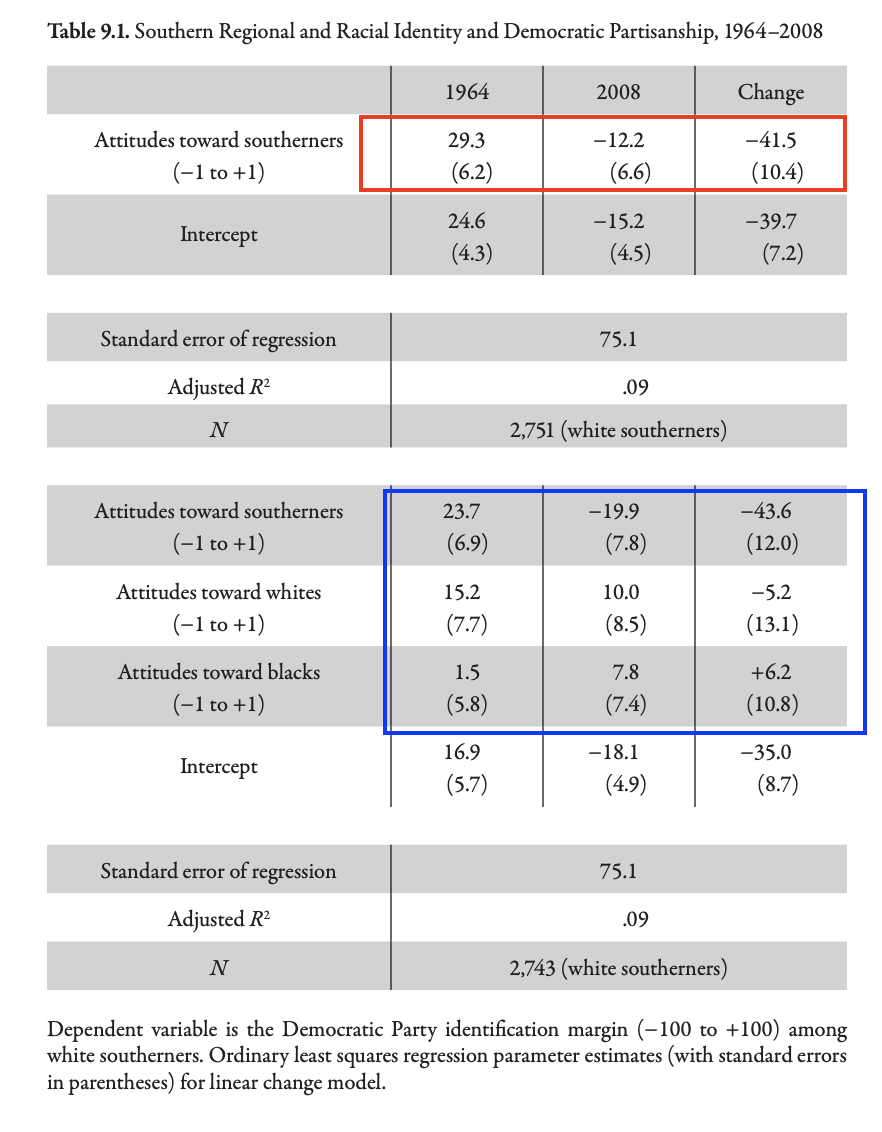
Regression Analysis


Regression Analysis
Was southern identity really the basis of these very different responses to the political events of the long southern realignment era?

Southern Identity and Partisan Identification
I find the model(s) in Table 9.1 a little confusing.
In the following tabs, I’ve plot some linear trends in Democratic Identification by year for:
- Feelings toward Southerners
- Feelings toward Whites
- Feelings toward Blacks
- Govt aid to Blacks




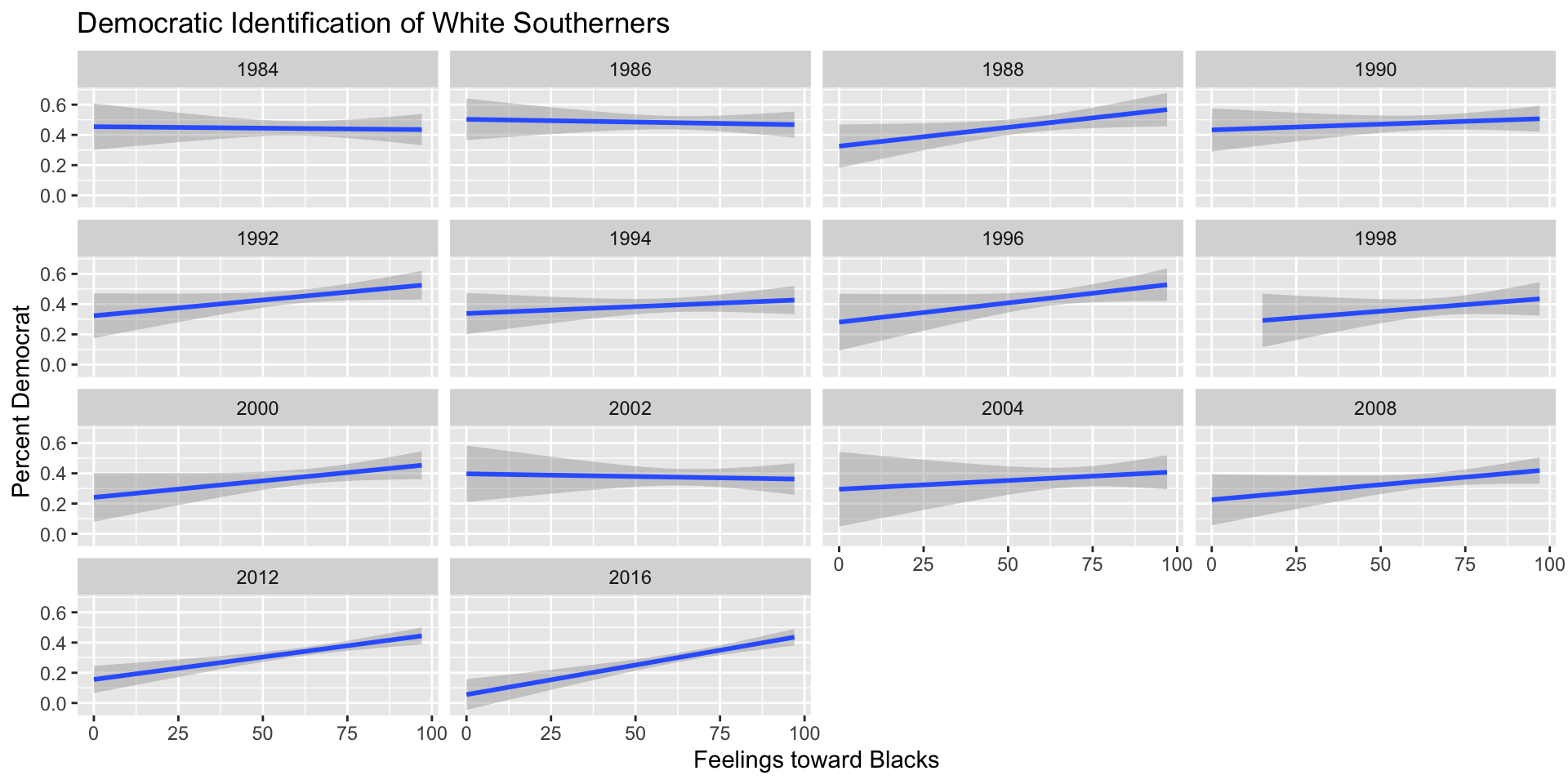

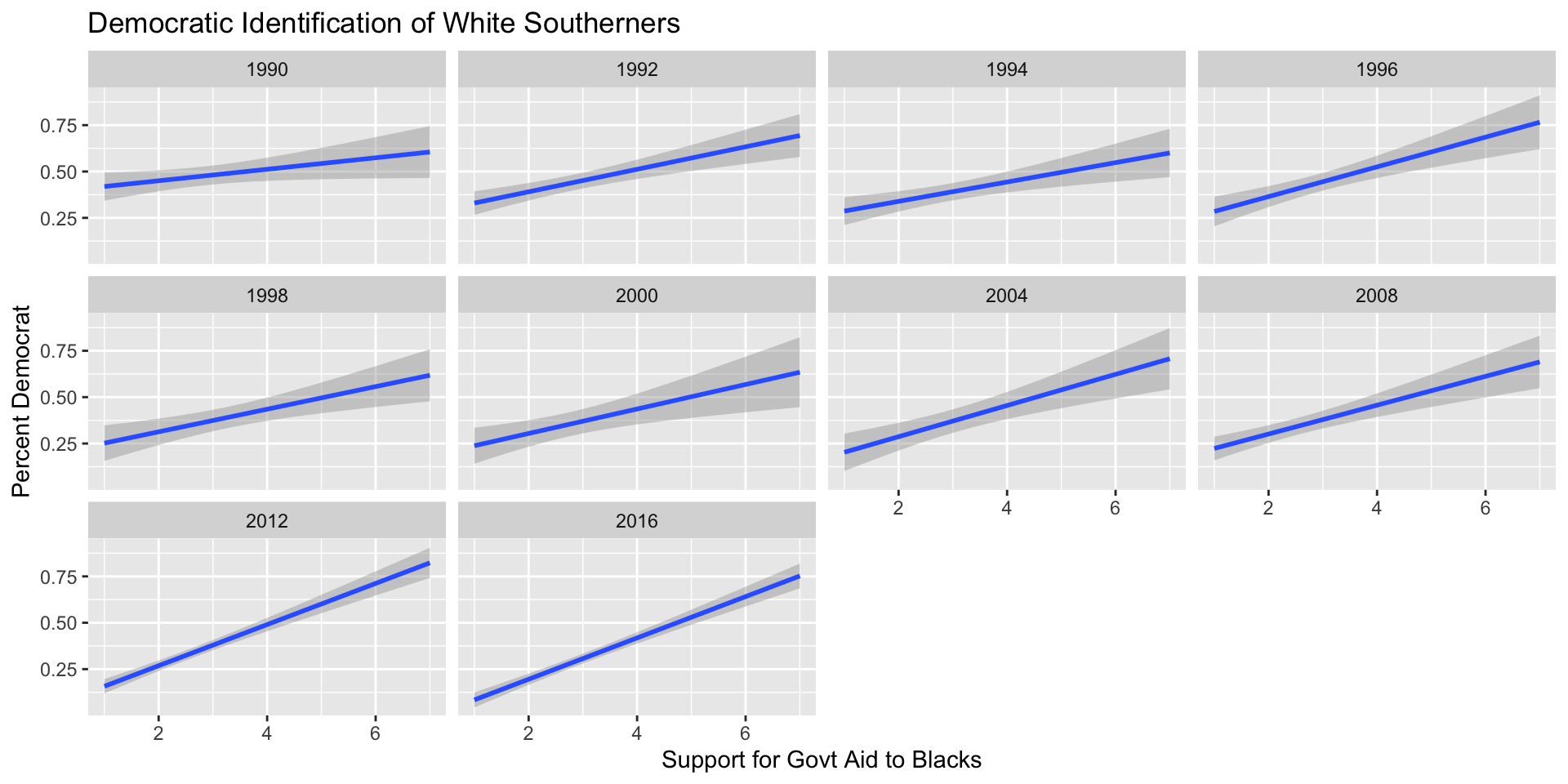
PID, Gender and Abortion
Who are we talking about?
Who changes parties given attitudes about abortion?
Who changes attitudes about abortion given party?
PID, Gender and Abortion
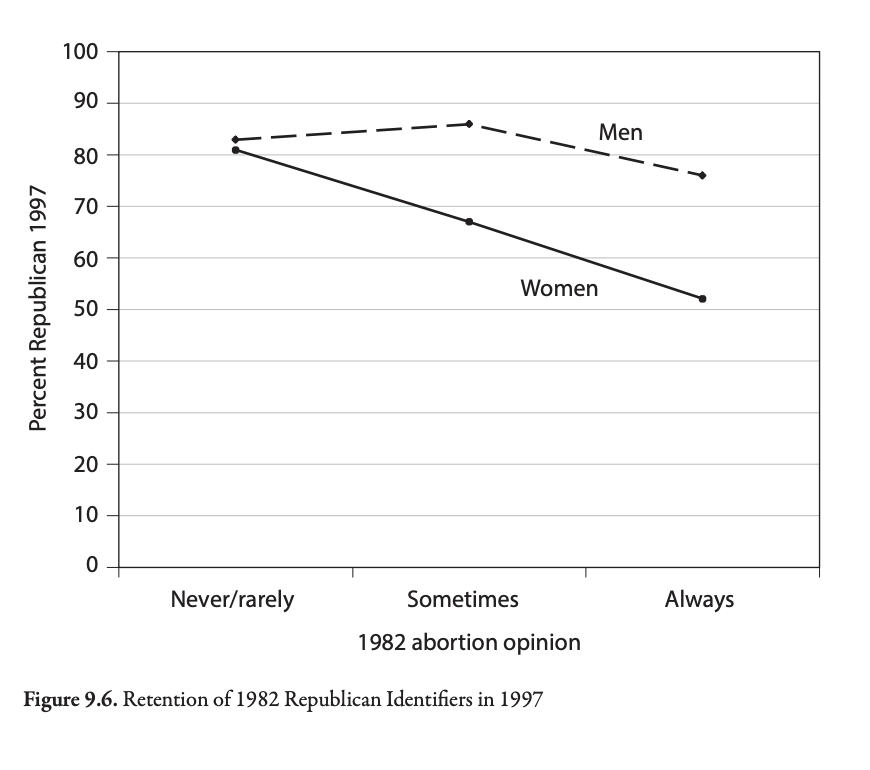
PID, Gender and Abortion

Pitfalls of Group Identity
Pitfalls of Group Identity (Chapter 10)
Achen and Bartels conclude by considering the role of partisan identities in politics, and look at:
- Partisan misperceptions of party positions
- Partisan misperceptions of objective facts
- The impact of scandals on unrelated partisan policies
Partisan misperceptions of party positions
- What do we learn from Figure 10.1
- How do individuals at the ends differ from individuals at the center of the scale
- Why are these differences important
People percieve parties as closer to the their own positions
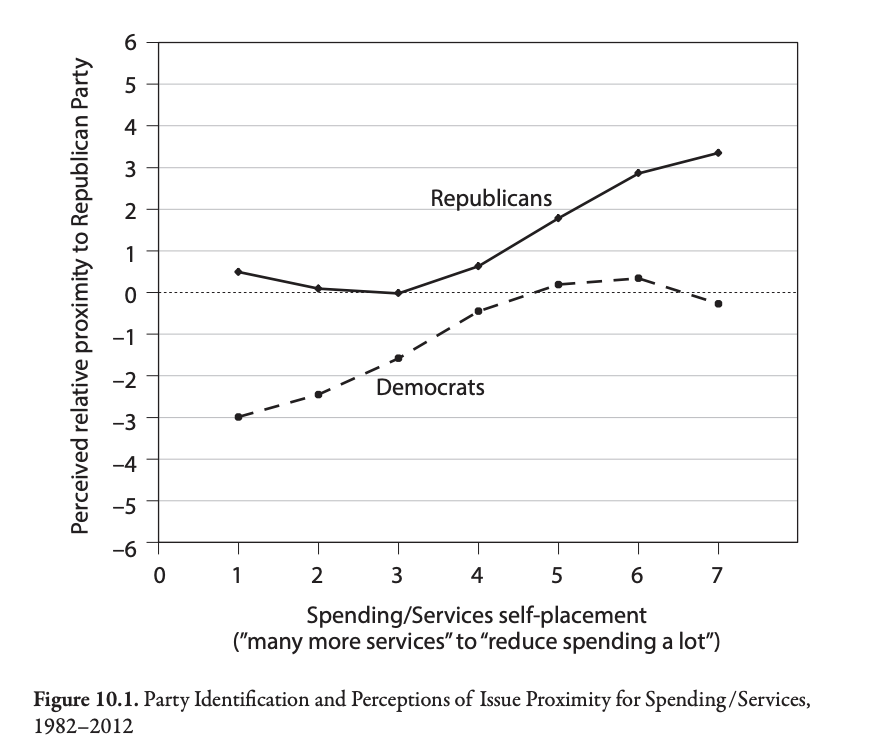
Partisan misperceptions of objective facts
- What are the key takeaways from table 10.1 and figure 10.2?
- How do these results relate to our earlier discussions of misinformation?
Partisanship increases misperceptions of objective facts

Misperceptions remain common among even as political information increases

The impact of scandals on unrelated partisan policies
What are the key coefficients in Table 10.2 and 10.3 for Achen and Bartel’s argument
How compelling and consistent are these results?
The impact of scandals on unrelated partisan policies

The impact of scandals on unrelated partisan policies

Next week: Huddy’s Critique of Achen and Bartels
Huddy offers several critiques of Democracy for Realists:
- A&B’s discussion of partisanship and abortion
- The nature of group politics
- The relevance and rationality of group interests
- The consequences of multiple identities of varying strengths
Why does she make these critiques? How compelling are they?
Let’s pick these questions up at the start of class on Monday

POLS 1140
Social Identity